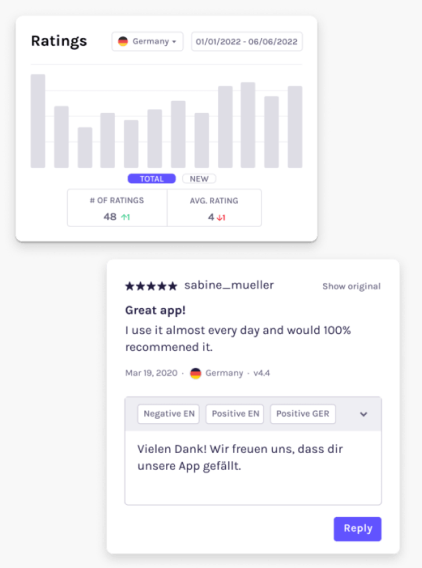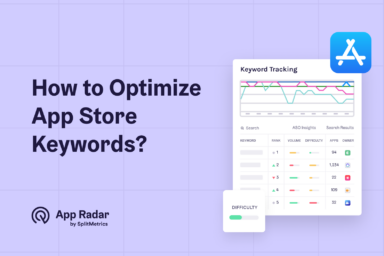App Store Ranking Factors: How to Grow Your iOS App (Updated With 2025 News)
Apple App Store ranking factors for mobile apps include app name, subtitle, keywords in the keyword field, downloads, user ratings, and reviews. App updates, retention rates, and in-app engagement also influence rankings. Optimizing them improves an app’s visibility and ranking in search results.

Ranking high organically in search results is one of the most challenging tasks of Apple app store optimization. It may only be possible with a strategic approach grounded in a solid understanding of the unique ranking factors of the App Store’s search algorithm.
This article will analyze all the factors influencing organic rankings on the App Store in 2024 and 2025, giving you actionable insights on App Store optimization.
How does the App Store ranking algorithm work?
The exact indexing mechanism of the Apple App Store ranking algorithm is undisclosed, as is the case on most (if not all) app marketplaces and web browsers. However, we can deduce that the algorithm first determines ranking eligibility if an app can rank for a keyword based on whether that keyword appears in the app’s metadata (app name, subtitle, and the keyword field). Second, the algorithm tries to understand how relevant your app is to a specific search query and ranks it accordingly (here, the app’s metadata also plays an important role).
Apps can sometimes rank for keywords not explicitly in their metadata by matching similar words or synonyms. This can also be observed in Apple Ads campaigns using the Search Match feature.
The ranking algorithm analyzes your app on two levels: eligibility and relevance. First, introduce the right keywords into your metadata. Second, prove that your app deserves top-ranking positions in search results.
The first step is straightforward and involves extensive keyword research and evaluation. App Radar provides all the tools to choose the best App Store keywords. It provides data on their popularity (organic traffic potential) and estimated ranking difficulty, considering how many competitors target them and how strong they are.

Being eligible for a ranking isn’t that difficult, but moving up in search results is. It revolves around proving the quality of your app or game to the algorithm and users.
Here, many factors are at play:
- High download velocity indicates a new and exciting app worth recommending
- A high number of downloads is proof an app is well-established.
- Positive reviews and many high ratings show there is an active user base
- Consequently, high tap-through and conversion rates will also impact rankings indirectly.
This means all visual assets (icons and screenshots), reviews, and ratings will have an effect. The list of relevant factors keeps growing, but each component makes sense. Let’s dissect them now.
How can you rank your app higher in App Store?
To rank your app higher in the App Store, focus on a multi-layered optimization approach that includes activites around different ranking factors:
- Optimize your app title and subtitle – place your most important keywords here as these carry the highest ranking weight
- Write keyword-rich app descriptions – include relevant keywords while maintaining readability for users
- Leverage screenshot captions – include keywords in caption text since Apple now indexes this content
- Maintain high ratings and reviews – achieve 4+ star ratings and encourage genuine reviews through in-app prompts
- Boost download velocity and conversion rates – create compelling screenshots and app previews that showcase your value proposition
- Ensure technical excellence – maintain regular updates, minimize crashes, and optimize loading times
- Utilize in-app events strategically – capture seasonal and trending searches through well-optimized events
- Create Custom Product Pages (CPPs) – target different audience segments, especially since CPPs now appear in organic search results
- Focus on user retention metrics – prioritize session length, daily active users, and long-term engagement
Success requires consistent optimization across all these factors rather than focusing on any single element. The following chapters explain each ranking factor in more detail.
App Store ranking factors with a direct impact on rankings
The following factors will have a direct effect on your organic rankings. App metadata will work to determine your ranking eligibility. At the same time, downloads and other app quality indicators will show the algorithm that your app deserves to be more visible to search users through a higher position.
App metadata
App metadata refers to three textual fields included in your app’s configuration. They can be managed through App Store Connect or App Radar’s ASO Workflow feature.

App Name
The iOS app name is among the most influential factors in keyword rankings. That’s because keywords placed in the App Name have the most considerable ranking weight. The best app name should include a unique keyword (your brand) and primary functionality. This pattern is well visible in the collage of apps presented above.
Subtitle
The app subtitle for iOS apps has the second strongest ranking power. Keywords you place in the subtitle should be those you can’t fit into your app name. Like the examples above, expand on your app’s key functionalities and selling points.
Keyword Field
The iOS keyword field is important for ASO because it exists solely to help the algorithm better understand your app. Keywords introduced in it aren’t visible to users. The keyword field offers the most freedom in describing your app with relevant keywords and comes third in ranking weight among the three metadata fields. Even competitor keywords can be included.
The critical component of your keyword optimization will be allocating the best keyword between these three fields, considering their search popularity, potential ranking difficulty, and relevance to your app. However, in the case of app name and subtitle, you can’t forget about the engagement factor, as a good, catchy name and subtitle will significantly impact tap-through and conversion rates. Address the algorithm’s and users’ needs while selecting keywords.
These three metadata fields have a confirmed impact on ranking eligibility. There’s speculation about the potential effects of the iOS app description, but we can’t confirm them. Regardless, writing an engaging, meaningful description seems like a good idea, just in case. This approach will benefit you should the algorithm be updated.

What are new App Store ranking factors Apple added in 2025?
Apple introduced several significant App Store algorithm updates and confirmed new ranking aspects throughout 2025, with many details emerging from their WWDC conference and subsequent developer communications. These updates include:
- Screenshot captions now impact rankings – caption text is actively indexed by Apple’s search algorithm
- In-app events integration – events are now considered when matching apps to user search queries
- Enhanced custom product pages – distinct keywords can now be assigned for each localization
- AI-generated tags introduction – Apple began testing automated tag generation in iOS 26 beta
Screenshot captions now impact mobile rankings
Apple made a significant algorithm change in June 2025 that fundamentally altered how screenshots contribute to App Store Search rankings.
Screenshot captions have evolved from simple visual descriptions to active ranking factors in Apple’s search algorithm. This June 2025 update means that the text you write in your screenshot captions now contributes to how your app ranks for specific keywords.
In-app events integration
The App Store algorithm now indexes in-app events and evaluates their relevance to user search queries. This means your scheduled events, tournaments, sales, and special content can directly contribute to your app’s discoverability for related searches.
Enhanced Custom Product Pages keyword targeting
Apple expanded the functionality of Custom Product Pages (CPPs). App marketers can now assign distinct keywords for each localization for more granular control over regional ASO strategies.
Even more important, Apple now allows Custom Product Pages (CPPs) to replace your default product page in organic search results when users search for specific keywords.
AI-generated tags introduction
Apple introduced AI-generated tags as part of the iOS 26 beta testing program as a potential shift toward automated metadata generation. These tags are created by Apple’s machine learning algorithms that analyze app content, functionality, and user behavior patterns to automatically suggest relevant keywords and categories.
They are currently in beta, but it show that Apple moves toward reducing developer control over metadata while potentially improving search accuracy through AI-driven content understanding.
App Store ranking factors with an indirect impact on rankings
All the factors listed below will contribute to your download velocity or are clear signals of engagement, the best evidence of an app worth recommending by the App Store. In one way or another, they’re proof of your mobile app’s quality.
Because the algorithm’s exact structure is undisclosed and all the elements listed are interconnected, it’s difficult (or impossible) to attribute each a specific ranking power. Unfortunately, there are no shortcuts in this area of optimization; you need a holistic approach.
As an ASO specialist or the leader of a small development and publishing crew, you’ll work with your team to provide App Store users with the best possible experience and communicate your app’s value as clearly as possible.
Following a comprehensive ASO competitive analysis, A/B testing of visuals, you’ll implement the most engaging ones. The app icon is an important factor for optimization of iOS apps as it’s visible in search results and on the product page. Screenshots are immensely important for high conversion rates. An app preview video in App Store also matters, with considerable differences depending on the app or game category. You’ll work to share an app that doesn’t crash and entices users to make in-app purchases or perform other meaningful actions.
The scope may seem impossibly large, but it can be done. Strive for the best experience for people, and it will work for the robot, too.
Download velocity
Download velocity is a performance metric that measures the number of downloads your app gets within a certain period. High download velocity indicates a fresh or recently updated app that new users eagerly try. It’s a powerful signal to pull it up in the rankings. The more downloads you can get, the higher your app will rank. This is why regular updates and in-app events will positively impact rankings, just like paid user acquisition, which may give your app or game enough momentum to start improving organically.
To boost your organic rankings, you will need paid user acquisition. This will be your biggest challenge initially, as the algorithm won’t have enough data on your app to recommend it to users safely. This is why even pre-order Apple Ads campaigns can boost organic rankings, as evidenced by the case study by SplitMetrics.
In-app engagement
In-app engagement is a clear indicator of high quality. Many apps are downloaded and never interacted with, or users don’t pass any significant milestones leading to revenue. Logically, apps with ongoing in-app purchases, subscriptions, ad displays, or high retention rates will be worth recommending.
App retention is a metric that shows the share of new users active in your app over a specific time, such as one day, week, or month, depending on your sales cycle.
There are no shortcuts to building a lasting, in-app engagement. The good news is that when you make improvements, you can inform even past users by releasing an update and creating events.
Uninstalls
High download velocity doesn’t paint the whole picture of the app’s quality. It’s possible to gain new users with keywords that aren’t relevant or ads that don’t bring a focused, engaged audience. Avoid low-value downloads because they may lead to low engagement and even uninstalls. They will harm your App Store rank.
App reviews and ratings
App Store ratings and review for iOS apps largely influence a person’s decision to download. People trust other people’s experiences. So when you have too many negative ratings and reviews, people won’t bother trying your app out. They’ll just move on to your competitors. To ensure your download velocity increases continuously, work towards engaging users to leave positive reviews and reply to negative ones.

The influence of App reviews and ratings goes beyond increasing your download velocity. Ratings directly impact rankings and increase the chances of your app being featured on the App Store in one of its lists or editorials. Improving your app ratings and reviews will help your app on multiple levels: rankings, featuring, and conversions.
Tap-through and conversion rates
High tap-through and conversion rates contribute to a higher download velocity and indicate an app well matched with a search query. Your app’s general conversion rate for its product page and conversion rates for specific keywords matter, so a holistic optimization approach is advised.

In search results, the app icon, title, and subtitle (and sometimes screenshots) will heavily impact your app’s tap-through rate. Strong visuals on a product page will tremendously impact conversion rates. An average user spends little time on an app’s page, relying heavily on visual communication. They typically scroll through only the first screenshots before downloading or going elsewhere.
However, don’t focus on tap-through and conversion rates as ranking signals. Instead, they serve as a means of increasing your download velocity and an early warning for potential reasons you’re not seeing any growth.
Other factors and considerations
Two more considerations might be significant when it comes to ranking:
- New apps on the App Store often receive a temporary uplift in organic rankings. This can last anywhere from a few days to a few weeks after launch. Commonly called the “new app boost,” this is designed to give new apps more visibility in search results and categories during their initial launch phase. Don’t miss this opportunity. Updated apps won’t observe this effect, but they may still enjoy increased visibility after an engaging update as their likelihood of being featured on the App Store increases.
- App performance metrics like crashes/stability may factor in. The algorithm aims to showcase apps that are more likely to be downloaded and provide a good user experience. It’s been confirmed that these are taken into account on Google Play; it’s safe to assume that they matter on the App Store, too (or will in the future).
However, you should always remember that the exact algorithm is undisclosed. It’s difficult to measure the impact of some of these factors by isolating them and observing how organic rankings change. There are indicators that quality that brings engagement does matter, and it’s safe to assume that it will matter even more in the future. Working towards your app being stable, engaging, and delivering on the promises made on its product page seems like a good idea, regardless of how many positions it will jump organically in search results.
Checklist of tasks for better App Store organic ranking
Having reviewed all the relevant App Store ranking factors, we can create a comprehensive task list for an ASO specialist striving to improve organic ranking and traffic:
Optimize your app metadata
Metadata optimization strategically allocates keywords between your app name, subtitle, and keyword field. It’s preceded by extensive keyword research and selection, taking into account keyword popularity, difficulty, and relevance.
Improve your app's conversion rate
Conversion rate optimization means choosing the most relevant and engaging keywords for your app’s title and subtitle to showcase its features and selling points properly. It also includes optimizing app icons, screenshots, and preview videos, as each element significantly impacts CR uplift if done right. In-depth ASO competitive review and analysis and A/B testing are crucial parts of this step.
Increase app downloads
Investing in paid user acquisition for your app may be unavoidable to gain meaningful momentum and start ranking organically. The algorithm needs data to process. Initially, even with the “new app boost” taken into account, aggregating it may be impossible without ads bringing more people to your app’s product page.
Get more positive ratings and reviews
You don’t have direct control over user ratings and reviews, but you can work towards improving them in the long run. Always replying to comments and being helpful will directly impact ratings and reviews. By maintaining positive relationships with your audience, you’ll have a big impact on your conversion rate. Remember, the difference between average conversion rates for apps with 3.X ratings is lower by a three-digit margin than apps exceeding 4.X ratings. Good App Store ratings and reviews for iOS apps are worth fighting for on the App Store.
Localize your app
App localization has a significant impact on conversion rates. If you’re planning international expansion, do it properly, going at least for a minimum viable localization (MVL) that typically involves translations and ensuring none of the in-app or in-game elements are offensive in a particular country and that it complies with local regulations.
Aiming for more cultural relevance, at least on a product page level, doesn’t have to be out of your reach. Simple tricks can significantly impact conversion rates, which might improve app visibility.

Update your app regularly
Updating signals active development and, if done right, increases your chances of being featured on the App Store in lists or editorials. Updates are frequently coupled with timed in-app events, leading to user re-engagement, which can significantly impact organic rankings. How often should you update your app? In the case of textual metadata, it’s around 4-6 weeks, but monitor your competitors closely and take sufficient data on conversions as an indicator of optimal update frequency.
Maintain good app performance
Google Play’s ranking algorithm includes app performance metrics like crashes/stability and battery consumption, and we have reasons to believe this might be the case with the App Store, too. Regardless of the actual impact, fixing crashes, excessive battery use, or bad performance will improve your in-app engagement and user retention rate, which do impact organic rankings.
Track your app’s performance, read and analyze reviews left on the product page, and encourage your team to take action. Regular updates matter to users, too, as they may signal that an app is actively maintained, which could be viewed positively.
Take advantage of the initial keyword boost
Extensive keyword research and evaluation are fundamental before your debut on the App Store. It’s your opportunity to invest in permanent visibility because of the new app boost. Ground your keyword strategy in actual App Store keyword data. Ensure your visuals are top-notch and seek other means of giving your app additional momentum, which means investing in paid traffic.
Consider using Apple Ads
Paid app promotion may give your app the necessary traffic volume for the algorithm to pick up and rank it. Out of all the paid user acquisition channels, Apple Ads have the most considerable potential to impact your organic rankings directly, as shown in this case study released by SplitMetrics.

Additionally, Apple Ads can target specific keywords on the App Store, the same ones you might try to rank for organically. Multiple instances of observed direct impact exist between keywords you bid on and organic positions for the same keywords.
The synergy between Apple Ads and ASO goes beyond the impact on rankings and driving traffic. Even if you’re dealing with ASO, it’s good to understand this channel, its metrics, and how it works, as it’s also a useful tool for keyword research on the App Store.
App Store Organic ranking: FAQ
How are top charts for iOS apps calculated?
Top charts are automated lists of app recommendations gathered by the App Store. They feature best-quality apps from various categories and it’s safe to assume that parameters and metrics used for organic rankings and placing your app in these lists are similar, if not the same. We can infer a few critical points about factors that likely influence top chart rankings:
- App downloads are a significant factor. Download velocity (rate of downloads over time) is also essential, but a certain threshold should be reached.
- Ratings and reviews play a role. The overall rating and the number of ratings themselves matter.
- Conversion rate is also considered, which makes sense because it’s a good indicator of the app’s potential performance once it’s on the list, and the algorithm strives to show users engaging and interesting collections.
However, the exact calculation and weighting of different factors for top charts are not explicitly understood. Apple and Google do not publicly disclose the precise algorithms used for their top charts.
Which tools help with getting better rankings in the App Store?
The key challenges to making an app start ranking high organically are insufficient keyword data and traffic that would help the App Store algorithm to understand better and evaluate the quality of our app or game. This means that two solutions are necessary for rankings to take off:
- Tools with keyword intelligence: reliable, accurate, and real data on organic keywords, rankings, and competitors;
- Tools that can drive high-quality traffic that will engage the audience visiting the app’s product page on the App Store.
App Radar offers comprehensive, robust tools for App Store keyword research and evaluation. It is grounded in real data and shows each keyword’s traffic potential and possible ranking difficulty based on a complex analysis of competitors’ rankings for it.
It’s also recommended to use App Store Connect for ASO, as it has analytics relevant to the scope of our work. App Radar can be integrated with the platform, allowing both metadata management across all markets and tracking of app performance.

We can provide you with all the information you need to select the best keywords to use in your app’s name, subtitle, and keyword field, but you might still need an additional boost from advertising. Consider using the free SplitMetrics Acquire Starter Plan, a platform for managing Apple Ads campaigns. This is the user acquisition channel most likely to give your rankings “a kick”.
ASO ranking signals: App Store vs Google Play
App Store and Google Play require individual ASO strategies, as their relevant app store optimization ranking factors differ significantly. In both cases, an app’s name plays a significant role in eligibility and conversions. However, keyword optimization for Google Play is closer to typical copywriting for SEO, as it involves mainly the long description, which should be a comprehensive and possibly engaging overview of the app’s functionality and selling points.
Outside of technical app store optimization factors, there may be other considerable differences: demographic characteristics may differ for the same app, as iOS and Android users are unique. The competitive landscape is also different, meaning ranking possibilities will vary for both marketplaces. App store top charts work similarly, considering many app quality indicators to recommend the best apps to their users.
However, in many ways, ranking factors for the App Store and Google Play are similar. Both marketplaces strive to recommend their users the best apps possible, focusing heavily on app quality and performance.
Final words
Improving organic rankings is a zero-sum game. If you want to climb the ladder, someone has to fall. Your competitors are the biggest reason your app is not ranking. For each keyword selected in your metadata, you’ll be compared against each other: your number of downloads, their velocity, ratings, reviews, quality… If your app is new, you must prove your worth against many established apps. This is why ASO competitive research is probably the most important step to make before planning your organic ranking strategy. Sometimes, the only solution is picking other keywords and slowly building your position with them.
Keyword Intelligence, Market Intelligence, Competitor Insights.
We have all the data to help you pick the right organic ranking strategy.
Latest Posts

Top 10 Most Downloaded Games in Google Play Store (July 2025 Update)
Google Play Store Listing Experiments: How to Run Native A/B testing for Android Apps for Free!
12 Best Mobile Measurement Partners (MMPs) to Consider for Your Mobile App Attribution in 2025
Custom Product Pages: How to Boost App Store Conversions With Precise App Store Targeting
Academy Lessons
Continue lessons



